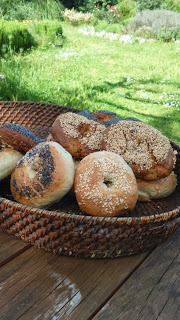The words of Mr Paul Hollywood ring in my ears as I write this post, as he said to a Great British Bake Off Contestant in 'Bagel Week' - 'what you've made there is bread'.
In the second edition of the Great Portuguese Bake Off, my friend and I decided to have a go at Bagels. We took a recipe from Dan Lepard, but I do have to say Mr Lepard is a little short on the descriptions of how and what your dough should look like to make it a good recipe.
So, half blind from the lack of descriptive text we started the test. Old school vs New school. I used traditional strong white flour, slow acting yeast and a lot of hand kneading and my friend used, ready to bake bread mix and a Kenwood and substituted the tablespoon of vinegar for bicarb of soda.
 |
| OLD SCHOOL |
It started well, things often do. Our dough looked similar. Nice and firm although my friends was a bit sticky following the Kenwood. We left them to rise. Mine doubled in size in an hour or so, but my friends were a little sorry for themselves so they got put in the sun to help them along.
 |
| FEELING QUITE PROUD |
 |
| ADDING HOLE NOT AS EASY AS IT SOUNDS |
It came to the boiling of the bagel dough. It turns out, this is quite important, as it stops your bagel becoming bread by stopping any rising in the oven, Mr Lepard does not explain that, instead he says to boil your bagel for 30 to 60 seconds....which is quite a big difference in dough world.
 |
| BOILING RAW DOUGH IS JUST ODD |
 |
| AFTER BOIL AND READY FOR THE OVEN |
I was thrilled, mine looked shiny, risen and started to fluff up in the oven as they went golden brown.
 |
| STILL PROUD |
My friend had a different experience, following the sunshine the dough had risen well, but as soon as you stick a finger in to make the bagel hole the dough seemed to shrink. Boiling them gave them too much brown colour (from the sugar in the boiling water) and in the oven the outside cooked too quickly making them very brown and underdone inside.
Despite the lovely looking display, the bagels were not quite bagels. Mine had not been boiled long or hard enough so rose in the oven making a bread like bagel, nice but without the chew needed for bagels. My friend's bagels went brown on the inside (white flour was used), they had a stronger malty quality and had almost 'shrunk' in the oven.
The shrinking was the over proving in the sunshine, the brown insides is anyone's guess....we don't know what caused this at all - the bread mix/the bicarb or the second hand boiling water boiling to hard to give too much colour throughout.....I have not been able to find a reason for this online.
I suppose it does not really matter, sitting outside in the afternoon sun with a bagel smothered in cream cheese and a chilled glass or two (or five) of white wine, it seemed less important to have a perfect bagel but more important to have a good friend and a fun day of bake off!
Next time - Eclairs!!
Watch the GBB bagel episode here.
Mr Lepard has updated his recipe from his book and a new version is online
http://www.theguardian.com/lifeandstyle/2007/sep/15/recipes.foodanddrink1









What a nice blog :-)
ReplyDelete